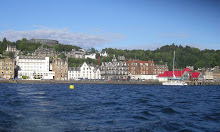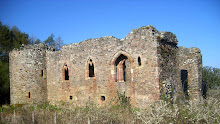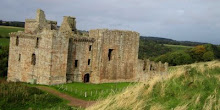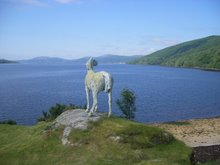This morning I travelled from my home in Nairn past Balbair where the government army camped prior to the Battle of Culloden, past the Loch of the Clans, past Kilravock Castle where the Duke of Cumberland reputedly had breakfast, and on to the site of that battle, 265 years ago on Drumossie Moor, where I attended the annual commemoration service.
It was perhaps appropriate that I approached from this direction since I am a Lowlander. I served in the British Army, in a regiment that stood in the Government front line that day. But one of my ancestors died fighting with the Jacobites in the 1715 Rising. So, like many Scots, my sympathies are split. I abhor Cumberland's cruelty following that battle. Equally, I condemn the arrogance that led to the whole misconceived enterprise, undertaken with no foreign assistance.
Seventy years earlier the 'Brahan Seer' had written "Oh! Drumossie, thy bleak moor shall, 'ere many generations have passed away, be stained with the best blood of the Highlands. Glad am I that I will not see the day, for it will be a fearful period." And so it was. An awful slaughter, the beginning of the end of the clan system.
As a tour guide, I am often at the battlefield. It's a familiar routine, explaining the battle to visitors. But I have never heard a Gaelic prayer, never heard a Piobaireachd, (the great pipe lament), spreading out over this familiar field. It becomes a different place, especially when surrounded by Highlanders who have been there numerous times before, and will come again, to pay respect.
Surrounded by descendants of those who died, I am even more appalled that for 76 years there were no markers at the mass graves of a thousand or more members of the Jacobite Army who fell that day. It was only in 1822 that Duncan Forbes of Culloden erected the present stones; the great grandchildren of the Inverness women who dug those graves told him which mound was which. It was only some 30 years ago that the 1835 road which bisected the graves was diverted to a discreet distance.
The swallows are recently arrived in Highland farmyards, baby rabbits scuttle on field fringes, skylarks sing over rough pasture and black-faced sheep that have been overwintered on the low ground are heading back to the hills. Just as it was in 1746.
And just as in 1746 Highlanders are dying for a cause that they cannot fully understand, not in the sleet of Drumossie Moor but in the dust of Afghanistan. As Allan Campbell, President of the Gaelic Society of Inverness, commented this morning, 'It is extraordinary that we never learn the folly of war'.
Saturday, April 16, 2011
Friday, March 25, 2011
The Clans - violence, honour and obligation
I was listening yesterday to a programme about Easter Island in the South Pacific; the commentator referred to 'rival clans'. Around Christmas in London I was in a taxi driven by a man from Somalia, who talked about the 'clans' who are controlling certain areas there. In both (random) cases there is an implication of violence: the clans in Easter Island finally eliminated one another and uncontrolled 'clans' was the reason that my Somali taxi driver was disinclined to return to his Somaliland home. The violence in 'Klan' is self evident.
My Shorter Oxford Dictionary (pub. 2007) gives four definitions for 'clan'; none has any violent or negative association. I believe that this fine word is now being corrupted.
It comes from the Gaelic clann which simply means 'children'. Clan is in fact a wholly positive word which speaks of honour, of commitment, of people supporting each another. In his excellent book 'Clans & Chiefs' Ian Grimble writes, '...the office...required that the chief should place his undefined patriachal obligations before his absolute feudal rights'. This was fundamental.
There aren't so many examples nowadays of 'undefined obligations' taking precedence over 'absolute rights'. And of course the other side of the coin was that clansmen were absolutely bound to fight and die in any fight that might be picked by the chief.
How wonderful, though, that in 2011 the Standing Council of Scottish Chiefs has a website ... and invites questions. An undefined obligation if ever there was one!
My Shorter Oxford Dictionary (pub. 2007) gives four definitions for 'clan'; none has any violent or negative association. I believe that this fine word is now being corrupted.
It comes from the Gaelic clann which simply means 'children'. Clan is in fact a wholly positive word which speaks of honour, of commitment, of people supporting each another. In his excellent book 'Clans & Chiefs' Ian Grimble writes, '...the office...required that the chief should place his undefined patriachal obligations before his absolute feudal rights'. This was fundamental.
There aren't so many examples nowadays of 'undefined obligations' taking precedence over 'absolute rights'. And of course the other side of the coin was that clansmen were absolutely bound to fight and die in any fight that might be picked by the chief.
How wonderful, though, that in 2011 the Standing Council of Scottish Chiefs has a website ... and invites questions. An undefined obligation if ever there was one!
Saturday, March 05, 2011
Happy Tenth Birthday... to Us!
It was ten years ago that Scottish Clans and Castles Ltd emerged from a mixed bag of other tourism projects.
And I'm delighted to have traced our first client, Angie Anstee (now Eikebu)... "It was 18th April 2001, my Norwegian husband's first trip with me to Scotland and we liked it so much we stayed two nights instead of the one that we booked!" The place, unsurprisingly, was Castle Stuart, an enduring favourite of our clients. And dear Caroline Stuart, the Chatelaine, has just emailed confirming more honeymooners this September.
Then, as now, our clients were primarily looking for holidays tailored to their personal requirements and clan connections. But a couple of years later we ran our first 'Outlander' Tour, a guided trip for fans of Diana Gabaldon's novels. It went well. Of our four clients two re-booked for the following year (and one is now running her own guiding operation in Minnesota). And last year we ran three 'Outlander' tours during one of which our guests dined with Diana Gabaldon and her husband at Castle Stuart.
The Year of Homecoming in 2009 was a milestone for us and about 300 of our clients enjoyed 'The Gathering' in Holyrood Park, Edinburgh.
This year, on our tenth anniversary, we are delighted to be launching two new products - 'Scottish Castle Escapes' and 'The Ultimate Highland Castle House Party', the latter being a luxurious weekend at Aldourie Castle on the banks of Loch Ness with private tours of local castles.
Now then... I'm thinking of a Castle birthday cake, candle on each turret...
And I'm delighted to have traced our first client, Angie Anstee (now Eikebu)... "It was 18th April 2001, my Norwegian husband's first trip with me to Scotland and we liked it so much we stayed two nights instead of the one that we booked!" The place, unsurprisingly, was Castle Stuart, an enduring favourite of our clients. And dear Caroline Stuart, the Chatelaine, has just emailed confirming more honeymooners this September.
Then, as now, our clients were primarily looking for holidays tailored to their personal requirements and clan connections. But a couple of years later we ran our first 'Outlander' Tour, a guided trip for fans of Diana Gabaldon's novels. It went well. Of our four clients two re-booked for the following year (and one is now running her own guiding operation in Minnesota). And last year we ran three 'Outlander' tours during one of which our guests dined with Diana Gabaldon and her husband at Castle Stuart.
The Year of Homecoming in 2009 was a milestone for us and about 300 of our clients enjoyed 'The Gathering' in Holyrood Park, Edinburgh.
This year, on our tenth anniversary, we are delighted to be launching two new products - 'Scottish Castle Escapes' and 'The Ultimate Highland Castle House Party', the latter being a luxurious weekend at Aldourie Castle on the banks of Loch Ness with private tours of local castles.
Now then... I'm thinking of a Castle birthday cake, candle on each turret...
Tuesday, February 01, 2011
"A daimen icker in a thrave"
A family group has just asked me to schedule a visit to Robert Burns birthplace. By coincidence I was there, at the new Burns Museum, last week.
I'm a great fan of Burns and, having been born and bred in Scotland, many words are familiar to me. But for those who do not enjoy that great privilege Burns can be a bit impenetrable! Take a daimen icker in a thrave for example; it's a line from 'To a Mouse'. Who has any idea what that means? (actually it means 'the occasional ear of corn in a set of sheaves').
I visited the museum with some other tour operators and we were inevitably concerned as to whether overseas clients would be able to understand it. The short answer was 'No'. Indeed the National Trust for Scotland has made the whole thing even less penetrable by writing the explanations on the show cabinets in Burnsian Scots, with difficult words translated. Not much good for overseas visitors.
But after a bit I mused that this is a celebration of Burns and his work. Should it not also be a celebration of his language? David Hopes, museum curator said, "Our intention has been to get under the skin of Burns, encouraging a creative response in the reader-visitor." A noble intention, and I think he has succeeded. But how important is the original language?
One translation of Burns into Russian apparently sold over 600,000 copies and Burns is still taught in Russian schools. But I'm sure Abraham Lincoln, who carried a volume of Burns' work with him, only read the original. And what of Steinbeck whose 'Of Mice and Men' was inspired by the ploughman poet and his line from 'To a Mouse': The best laid schemes o' mice an' men / Gang aft agley.'? How did he make sense of it? 'Translated' or not? Well, maybe some scholars can help me with that.
I do not believe that Scots is a language in its own right. But if traditional words and syntax are not used somewhere today, will it only be future academics who can revel in the earthiness and wonderful rhythms of Burns' poetry?
When I had seen the museum I wandered over to the old Brig o' Doon (of Tam o' Shanter fame) and the nearby Burns Monument, where I learned that there are 58 monuments to Burns around the world. Fifty-eight! More than any other poet.
This does not, of course, make him the world's greatest poet but it does convince me that Burns should not be celebrated in translation.
I'm a great fan of Burns and, having been born and bred in Scotland, many words are familiar to me. But for those who do not enjoy that great privilege Burns can be a bit impenetrable! Take a daimen icker in a thrave for example; it's a line from 'To a Mouse'. Who has any idea what that means? (actually it means 'the occasional ear of corn in a set of sheaves').
I visited the museum with some other tour operators and we were inevitably concerned as to whether overseas clients would be able to understand it. The short answer was 'No'. Indeed the National Trust for Scotland has made the whole thing even less penetrable by writing the explanations on the show cabinets in Burnsian Scots, with difficult words translated. Not much good for overseas visitors.
But after a bit I mused that this is a celebration of Burns and his work. Should it not also be a celebration of his language? David Hopes, museum curator said, "Our intention has been to get under the skin of Burns, encouraging a creative response in the reader-visitor." A noble intention, and I think he has succeeded. But how important is the original language?
One translation of Burns into Russian apparently sold over 600,000 copies and Burns is still taught in Russian schools. But I'm sure Abraham Lincoln, who carried a volume of Burns' work with him, only read the original. And what of Steinbeck whose 'Of Mice and Men' was inspired by the ploughman poet and his line from 'To a Mouse': The best laid schemes o' mice an' men / Gang aft agley.'? How did he make sense of it? 'Translated' or not? Well, maybe some scholars can help me with that.
I do not believe that Scots is a language in its own right. But if traditional words and syntax are not used somewhere today, will it only be future academics who can revel in the earthiness and wonderful rhythms of Burns' poetry?
When I had seen the museum I wandered over to the old Brig o' Doon (of Tam o' Shanter fame) and the nearby Burns Monument, where I learned that there are 58 monuments to Burns around the world. Fifty-eight! More than any other poet.
This does not, of course, make him the world's greatest poet but it does convince me that Burns should not be celebrated in translation.
Saturday, January 22, 2011
A Witch's Cursing Bone
It was a familiar voice on the car radio. But until he started talking about ancestry I hadn't recognised Bruce Durie, genealogist, broadcaster and chairman of the Ancestral Tourism Steering Group on which I sit. When he moved on to the cursing bone of Katherine McNure of Glen Shira, I stopped the car to listen.
The 'bone' in question is now in the National Museum of Scotland, Edinburgh. Further illumination is given by this 'Extract from the Proceedings of the Society of Antiquaries of Scotland Vol.78 (1943-1944) pg141:
Witch’s Cursing-bone consisting of the marrow bone of a deer or sheep, stained deep brown by peat, and fixed through a diamond-shaped pice of bog oak. It was formerly the property of a reputed witch living at the head of Glen Shira, Argyll. According to the local tradition,“When the “witch” wanted to “ill will” one of her neighbours, she went out with her bone between sunset and cock-crow and made for the neighbour's croft. She did not go to the dwelling-house, however, but to the hen house and seized the hen that sat next to the rooster (his favourite), thrawed its neck, and poured its blood through the cursing bone, uttering her curses the while.
I am reminded of Isobel Gowdie, from Auldearn, just two miles from here in Nairn, who gave a full and detailed confession of the doings of her coven at her trial in 1662. I have read the full transcript and she seems really quite proud of her doings - even giving the magic spell by which a witch can turn herself into a hare, then back to a witch.
But soon (25 Jan) it is Burns Night and I finish with my favourite witch: 'Nannie' famous for her 'cutty sark', short skirt, in Robert Burns' epic tale, Tam o' Shanter.
Satan is blowing the pipes, the witches are dancing, Tom is captivated, his horse Maggie terrified...
The 'bone' in question is now in the National Museum of Scotland, Edinburgh. Further illumination is given by this 'Extract from the Proceedings of the Society of Antiquaries of Scotland Vol.78 (1943-1944) pg141:
Witch’s Cursing-bone consisting of the marrow bone of a deer or sheep, stained deep brown by peat, and fixed through a diamond-shaped pice of bog oak. It was formerly the property of a reputed witch living at the head of Glen Shira, Argyll. According to the local tradition,“When the “witch” wanted to “ill will” one of her neighbours, she went out with her bone between sunset and cock-crow and made for the neighbour's croft. She did not go to the dwelling-house, however, but to the hen house and seized the hen that sat next to the rooster (his favourite), thrawed its neck, and poured its blood through the cursing bone, uttering her curses the while.
I am reminded of Isobel Gowdie, from Auldearn, just two miles from here in Nairn, who gave a full and detailed confession of the doings of her coven at her trial in 1662. I have read the full transcript and she seems really quite proud of her doings - even giving the magic spell by which a witch can turn herself into a hare, then back to a witch.
But soon (25 Jan) it is Burns Night and I finish with my favourite witch: 'Nannie' famous for her 'cutty sark', short skirt, in Robert Burns' epic tale, Tam o' Shanter.
Satan is blowing the pipes, the witches are dancing, Tom is captivated, his horse Maggie terrified...
'Even Satan glowr'd, and fidg'd fu' fain
And hotch'd and blew wi' might and main
Till first ae caper, syne anither
Tam tint his reason a' thegither
And roars out, "Weel done, Cutty-sark!"
And in an instant all was dark
And scarcely had he Maggie rallied
When out the hellish legion sallied.'
The new Robert Burns Birthplace Museum opened today, 22 January 2011.
I look forward to visiting on Monday and will report back.
Subscribe to:
Posts (Atom)






























































